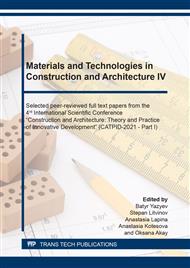p.1
p.9
p.15
p.27
p.37
p.43
p.49
p.55
Recipe and Technological Factors’ Influence on Vibrocentrifuged Basalt Fiber Concrete Strength and Deformation Properties
Abstract:
In order to optimize the basalt-fiber-concrete mixtures compositions, as well as to determine the most effective technological parameters in vibrocentrifugation technology, a compositional plan of experiments has been developed. Within the framework of the proposed experimental setup for creating vibrocentrifuged samples of annular cross-section with a variatropic structure, the following technological factors have been identified and considered: the clamps’ technological protrusions height; vibration mode (asynchronous - A, punctuational - P, synchronous - S). The clamps’ technological protrusions height varied within the following limits: 2.5 mm; 5 mm; 10 mm. The change in the percentage of coarse aggregate fractions and the percentage of fiber reinforcement was considered as the prescription factors. The percentage of fiber reinforcement varied within the following limits: 3.5%; four %; 4.5%. The content of fraction 5-10 in relation to fraction 10-20 varied within the following limits: 40 %; 50 %; 60 %. Based on the results obtained, it can be concluded that the most effective will be the use of clamps with a height of technological protrusions equal to 5 mm, with an alternating vibration mode, a percentage of fiber reinforcement equal to 4, and with a content of fractions of 5-10 mm and 10-20 mm equal percentage.
Info:
Periodical:
Pages:
15-25
Citation:
Online since:
August 2021
Price:
Сopyright:
© 2021 Trans Tech Publications Ltd. All Rights Reserved
Share:
Citation:


